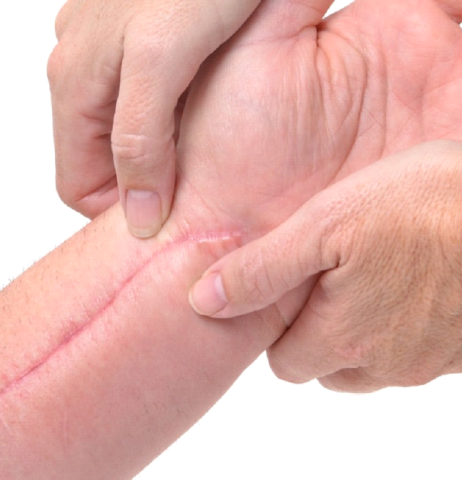
About Scar Therapy
My area of specialism is with scars and all sorts of soft tissue injury, accident, illness and trauma. Scars and their effects are not always visible…never underestimate the non-visible impact of a trauma to the body. Much can be done to help the hidden scars and scar tissue.
This gentle treatment can help on many levels. For example, if you have tightness, pain, restriction, numbness or some other form of physical sensation, this can ease off allowing freer movement and less restriction. Some results I have seen in my clients are being able to play sport with more strength, carrying out physical work with ease, picking up kids/grandkids without wincing or saying “no”.
Scar therapy is a focused and gentle method of working with scars and injuries. This helps the body to relax and heal, reconnecting on the scar surface and reducing adhesions in the underlying tissues, improving the condition of the scar and surrounding tissues.
By using a variety of hands on massage techniques I help facilitate the tissue to release tension and promote further healing.
This can be done on very old scars too...I have been amazed at what changes happen in scars 40, 50 years old!
You might think “Isn’t a scar just a mark on the skin, something to try to ignore or forget about?”
A scar is much more than just a mark left on the skin. From a physical point of view it might be tight or numb or have a weird sensation meaning you don’t like to touch it, or clothes might feel uncomfortable, or you can feel tightness when you move or bend in a certain way. Visually it might be raised or red or lumpy or you just don’t like to look at it. But also the scar tissue goes deeper than the surface of the skin having, potentially, significant impact across the whole of the body, or maybe just in one localised area which then affects the rest of the body.
Scar tissue is connective tissue replacing the pre-injury tissue. In the best case scenario it's thought to be 70-80% functional compared to pre-injury, which means that even the seemingly perfect scar has lost around 20-30% functionality.
If you have a scar, or even an injury that resulted in internal damage (e.g. torn ligaments/muscle/fascia etc.), then your body has done an amazing thing to firstly heal and then adapt to the scar formation.
What this means is that your body is being loaded differently putting strain elsewhere in the body. Possibly leading to further issues later in life - such as another injury, less mobility, strain on joints...
Even a limp after a sprained ankle will 'throw' the body mechanics and balance off causing mild to significant issues later down the line (personal experience of this one!). Or even a limp due to joint pain over a few years, once the joint pain has been remedied (probably by surgery), and you no longer have pain and think you are walking well...that imbalance over the years of limping has settled in your body. Adding in the loss of functionality from the scar (which don't forget is mostly internal as well as the visible mark on the skin) we might think that's it, just accept it.
And this is where massaging a scar (in the most appropriate way for the body!) comes into play. Massage can help reduce the lumpiness or redness, and help soften tightness which might be felt elsewhere in the body. Normal sensation can often be encouraged to return by freeing trapped nerves in the tight and constricted scar tissue.
Some of the scars I have treated:
⦁ Chest related surgeries – mastectomy, lumpectomy, open heart surgery, breast reduction
⦁ Joint replacement – hip, knee, shoulder
⦁ Abdominal procedures – laparoscopic investigations, caesarian, hysterectomy, appendectomy, bowel resection, gall bladder removal, kidney surgery…and many more
⦁ Head, face and neck – facial reconstruction, thyroid surgery, lip injury, throat cancer
⦁ Other musculoskeletal scars – lower limb fasciotomy, arthroscopic cleaning (knee, shoulder), power-tool injury, skin graft, Achilles tendon surgery…and many more
⦁ Burns and scalds
I have also used the techniques with success on non-skin-puncture injuries (i.e. no visible scar) including after a skiing accident which left a dent in the thigh.
© Lynne Roscrow
powered by WebHealer
